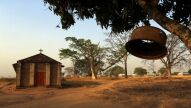3D images of sites in Middle East gathered to preserve history

The crisis in the Middle East and North Africa has resulted to a lot of damage to historical sites and priceless artifacts. The mass destruction has prompted historians, members of the academia and governments to find a way to preserve the sites, if only through 3D images. The Institute for Digital Archaeology has launched a project aimed at doing this.
Called Million Image Database, the endeavor is a joint project of several groups.
"In collaboration with UNESCO, engineering specialists at Oxford University, our other academic partners, and the government of the United Arab Emirates, we are in the process of capturing millions of 3D images of threatened objects," the institute explains in its website. "Armed with lightweight, discreet and easy-to-use 3D cameras, our dedicated volunteer photographers are capturing high quality scans at important sites in conflict zones throughout the Middle East and North Africa."
Early this year, the institure distributed low-cost but high-tech cameras to volunteer photographers who would take images of the sites located in areas where there is conflict. Numbering about 5,000, these cameras can take high quality images for inclusion in the institute's open-source database, for use in "research, heritage appreciation, educational programs and 3D replication."
The institute will be producing the first full-scale replication of a heritage site this April by means of "proprietary cement-based 3D printing techniques." According to Breitbart, this will be the triumphal arc of Palmyra, a site destroyed by IS last October, which will be displayed in Times Square in New York and Trafalgar Square in London. Other replicas will be made throughout the year until 2017.
Meanwhile, in Syria, French and Syrian archaeologists are also working together to capture images of the country's sites that are threatened by the presence of the terror group Islamic State. According to The Christian Post, the endeavor is a joint project of the Syrian Directorate General of Antiquities and Museums and Iconem, a French imaging company.
Maamoun Abdulkarim, head of DGAM, said, as quoted by Breitbart, "This solution gives our archaeological sites a real hope of renaissance and allows the memory of them to be preserved, no matter what happens."
 Christians don't have to affirm transgenderism, but they can’t express that view at work: tribunal
Christians don't have to affirm transgenderism, but they can’t express that view at work: tribunal Archaeology discovery: Medieval Christian prayer beads found on Holy Island
Archaeology discovery: Medieval Christian prayer beads found on Holy Island Presbyterian Church in America votes to leave National Association of Evangelicals
Presbyterian Church in America votes to leave National Association of Evangelicals Over 50 killed in 'vile and satanic' attack at Nigerian church on Pentecost Sunday
Over 50 killed in 'vile and satanic' attack at Nigerian church on Pentecost Sunday Ukrainian Orthodox Church severs ties with Moscow over Patriarch Kirill's support for Putin's war
Ukrainian Orthodox Church severs ties with Moscow over Patriarch Kirill's support for Putin's war Islamic State kills 20 Nigerian Christians as revenge for US airstrike
Islamic State kills 20 Nigerian Christians as revenge for US airstrike Man who served 33 years in prison for murder leads inmates to Christ
Man who served 33 years in prison for murder leads inmates to Christ


 Nigerian student beaten to death, body burned over ‘blasphemous’ WhatsApp message
Nigerian student beaten to death, body burned over ‘blasphemous’ WhatsApp message 'A new low': World reacts after Hong Kong arrests 90-year-old Cardinal Joseph Zen
'A new low': World reacts after Hong Kong arrests 90-year-old Cardinal Joseph Zen Iran sentences Christian man to 10 years in prison for hosting house church worship gathering
Iran sentences Christian man to 10 years in prison for hosting house church worship gathering French Guyana: Pastor shot dead, church set on fire after meeting delegation of Evangelicals
French Guyana: Pastor shot dead, church set on fire after meeting delegation of Evangelicals ‘Talking Jesus’ report finds only 6% of UK adults identify as practicing Christians
‘Talking Jesus’ report finds only 6% of UK adults identify as practicing Christians Mission Eurasia ministry center blown up in Ukraine, hundreds of Bibles destroyed: 'God will provide'
Mission Eurasia ministry center blown up in Ukraine, hundreds of Bibles destroyed: 'God will provide' Church holds service for first time after ISIS desecrated it 8 years ago
Church holds service for first time after ISIS desecrated it 8 years ago Burger King apologizes for 'offensive campaign' using Jesus' words at the Last Supper
Burger King apologizes for 'offensive campaign' using Jesus' words at the Last Supper Uganda: Muslims abduct teacher, burn him inside mosque for praying in Christ’s name
Uganda: Muslims abduct teacher, burn him inside mosque for praying in Christ’s name